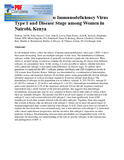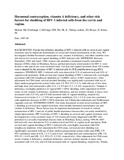Search
Now showing items 1-10 of 19
Subtypes of Human Immunodeficiency Virus Type 1 and Disease Stage among Women in Nairobi, Kenya
(1999)
In sub-Saharan Africa, where the effects of human immunodeficiency virus type 1 (HIV-1) have been most devastating, there are multiple subtypes of this virus. The distribution of different subtypes within African populations ...
Breastfeeding and immunity to intestinal infections
(1995)
The purpose of this study was to compare immune response in breast and non breastfed children presenting with diarrhoea at Paediatric Observation Ward, Kenyatta National Hospital (KNH-POW) and Maternal and Child Health ...
The importance of core groups in the epidemiology and control of HIV-1 infection
(1991)
In Africa, HIV transmission occurs mainly through heterosexual intercourse. High-frequency transmitter core groups are key to the epidemiology of HIV-1 and STD on the continent. The rapid growth of the HIV-1 epidemic in ...
Preparation for AIDS vaccine evaluation in Mombasa, Kenya: establishment of seronegative cohorts of commercial sex workers and trucking company employees.
(1994)
In preparation for human immunodeficiency virus (HIV) prophylactic vaccine trials, prospective cohorts of HIV seronegative female commercial sex workers and male trucking company employees were established in Mombasa, ...
Rapid progression to disease in African sex workers with human immunodeficiency virus type 1 infection
(1995)
From a cohort of female sex workers in Nairobi, Kenya, 163 women were observed to seroconvert to human immunodeficiency virus type 1 (HIV-1) and followed to study progression to HIV-1-related disease. The effect of several ...
Genital shedding of human immunodeficiency virus type 1 DNA during pregnancy: association with immunosuppression, abnormal cervical or vaginal discharge, and severe vitamin A deficiency
(1997-01)
The presence of human immunodeficiency virus type 1 (HIV-1) in genital secretions may be a determinant of vertical HIV-1 transmission. Cervical and vaginal secretions from HIV-1–seropositive pregnant women were evaluated ...
Stable antenatal HIV-1 seroprevalence with high population mobility and marked seroprevalence variation among sentinel sites within Nairobi, Kenya.
(1999)
Objectives: To monitor and analyse trends in HIV-1 seroprevalence among
antenatal women in Nairobi, Kenya.
Design: Six sequential surveys were carried out among antenatal clinic attenders at
four Nairobi City Council ...
Cervical and vaginal shedding of human immunodeficiency virus type 1-infected cells throughout the menstrual cycle
(University of Nairobi, 1998-10)
Cervical and vaginal secretions from 17 women infected with human immunodeficiency virus type 1 (HIV-1) were evaluated daily through the course of one menstrual cycle for HIV-1 DNA (21-31 visits per woman). HIV-1-infected ...
Hormonal contraception, vitamin A deficiency, and other risk factors for shedding of HIV-1 infected cells from the cervix and vagina.
(University of Nairobi, 1997-09)
BACKGROUND: Factors that influence shedding of HIV-1 infected cells in cervical and vaginal secretions may be important determinants of sexual and vertical transmission of the virus. We investigated whether hormonal ...
Mother-child class I HLA concordance increases perinatal human immunodeficiency virus type 1 transmission
(University of Nairobi, 1998-03)
Major histocompatibility complex (MHC) gene products are expressed on human immunodeficiency virus (HIV)-infected cells and incorporated into the lipid envelope of HIV virions. Macaques immunized with human MHC gene products ...










